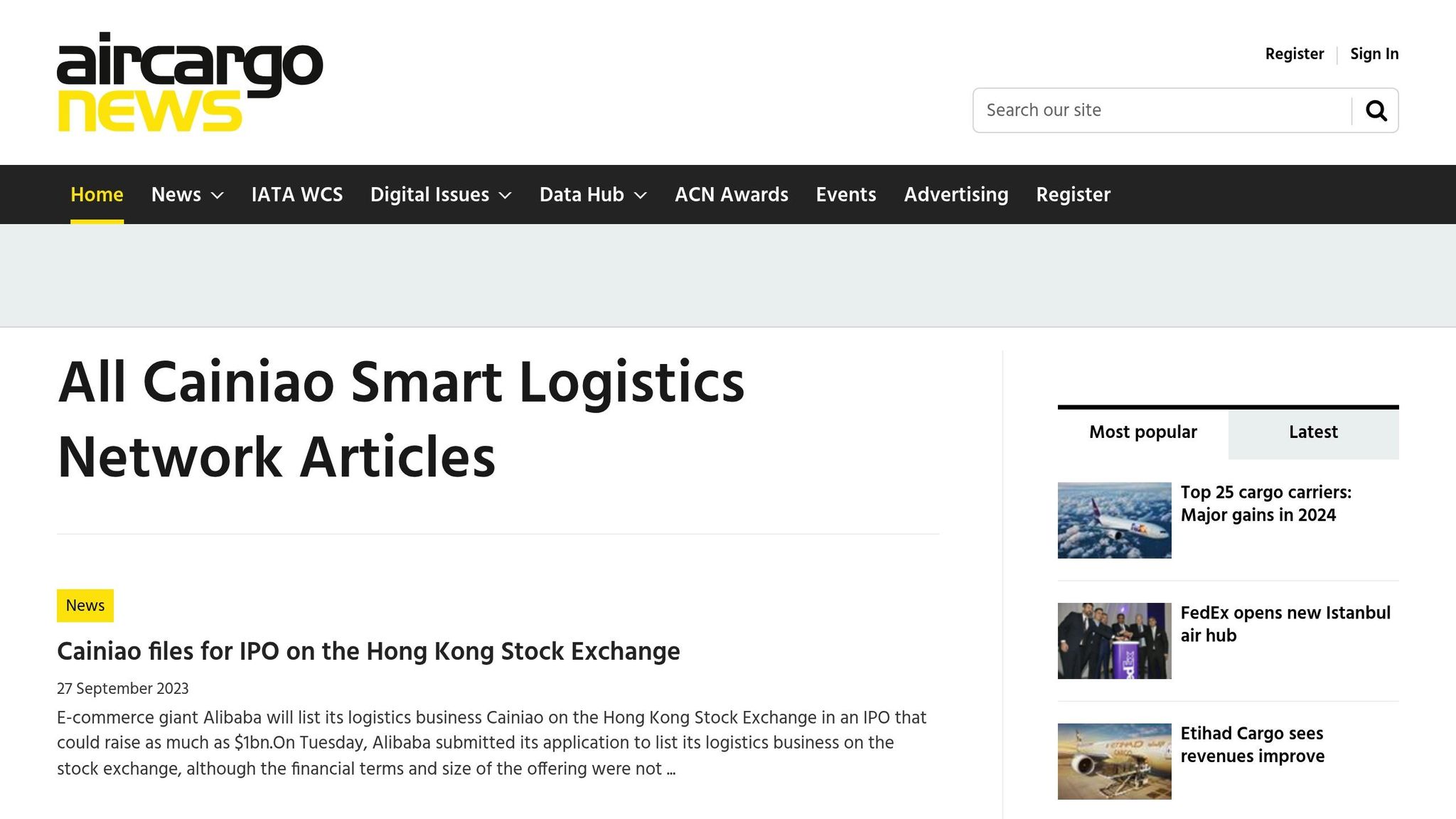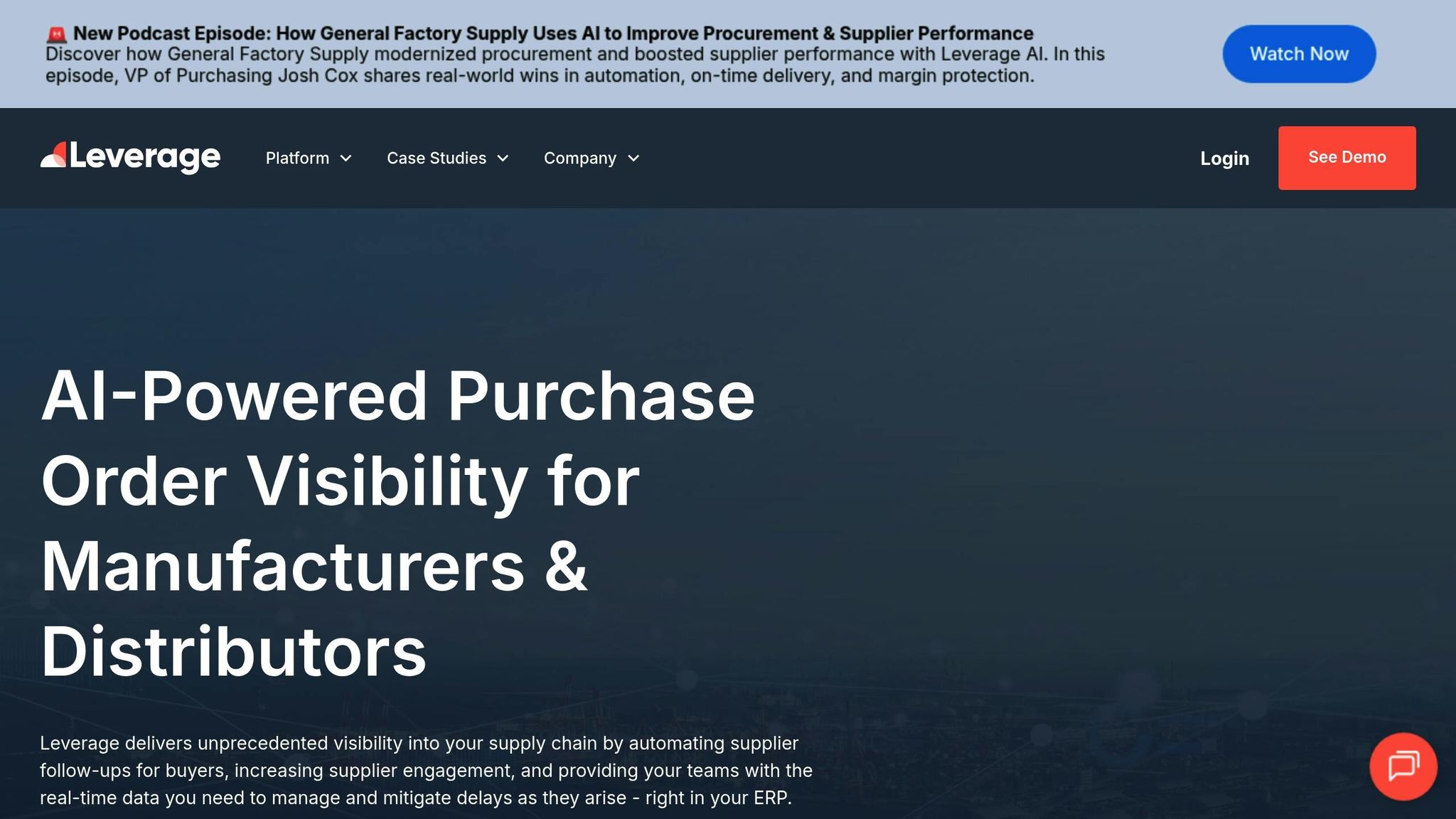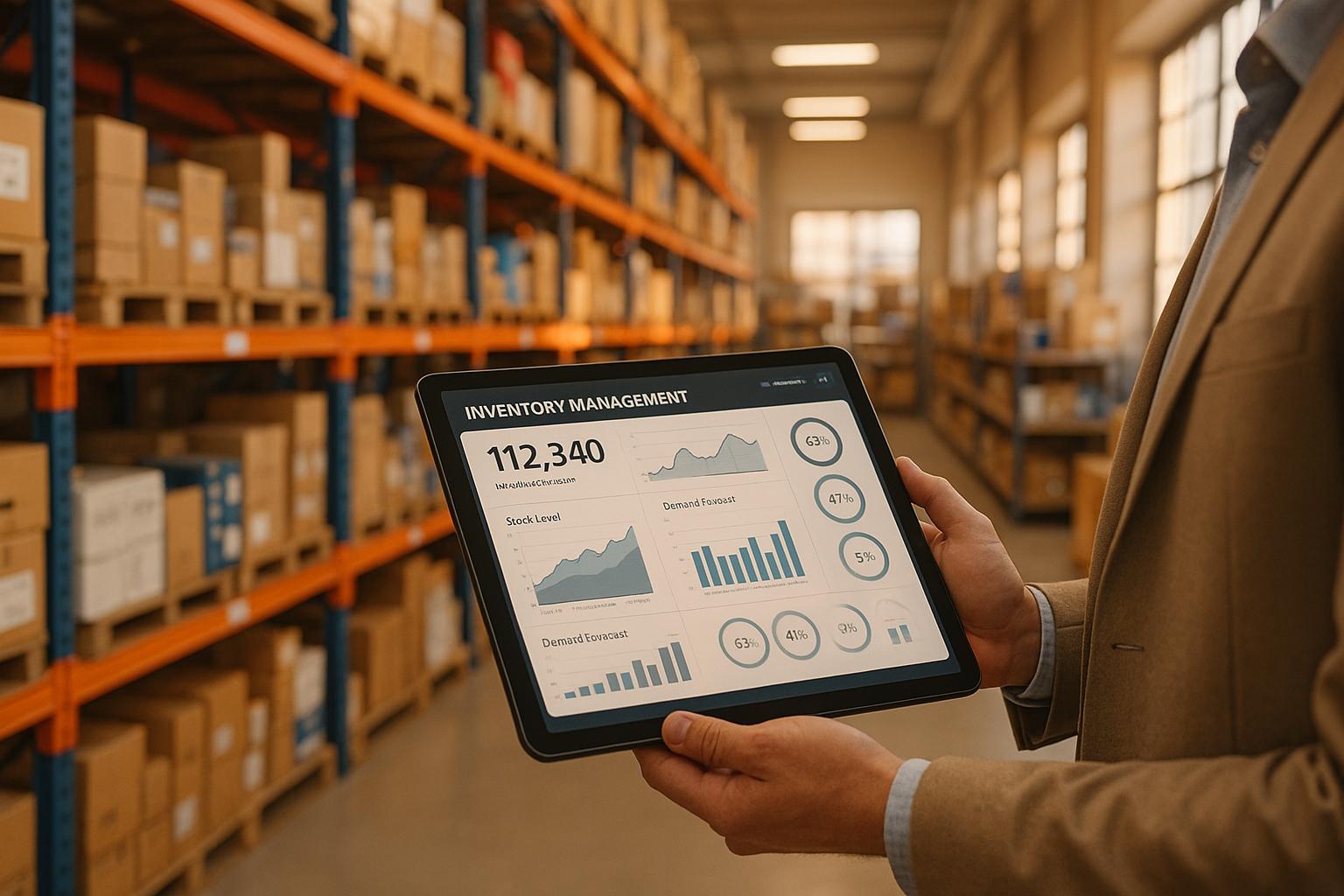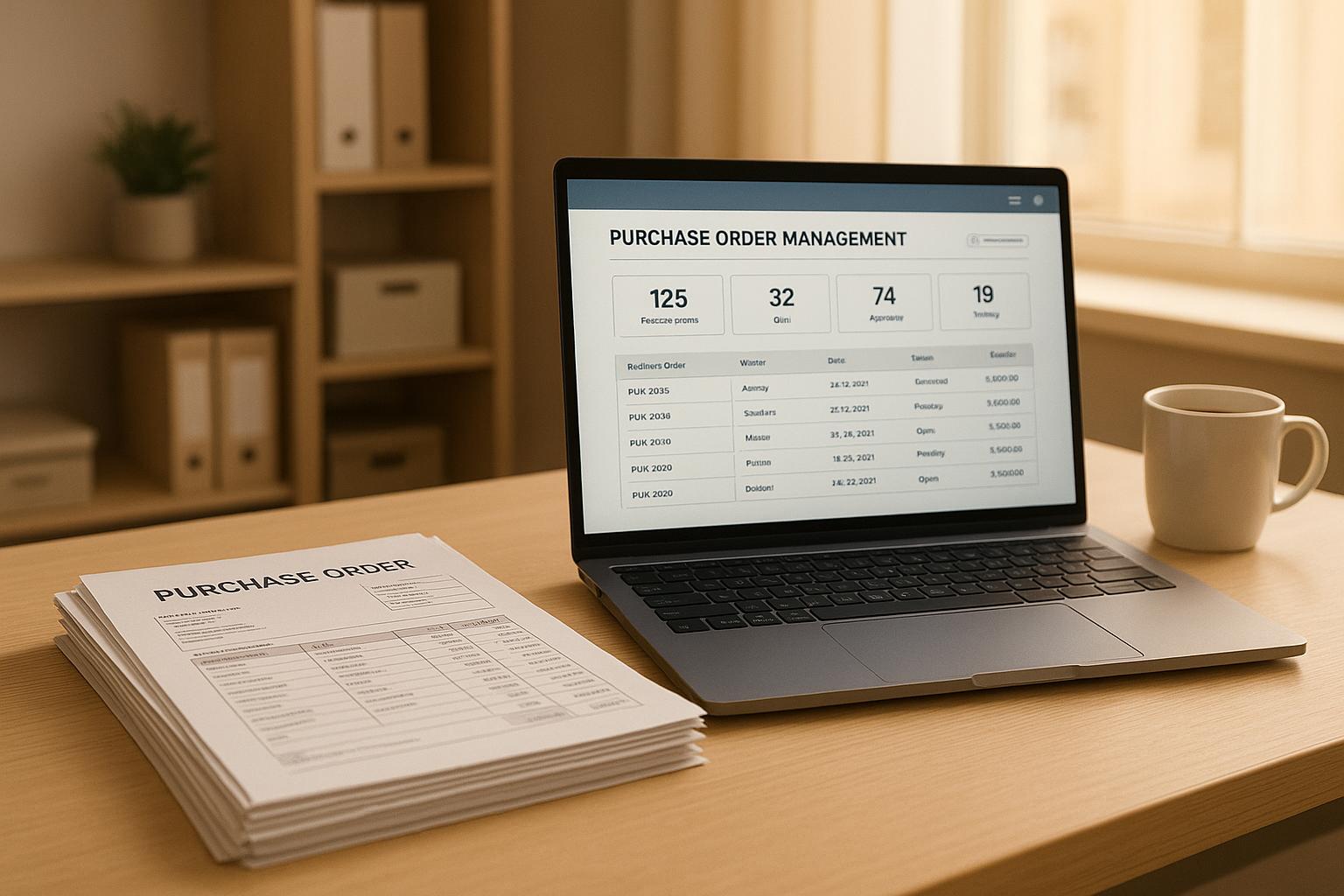How Real-Time Shipment Tracking Improves Supply Chains
.png?width=50&height=50&name=elizabeth-anderson-square%20(1).png)
Real-time shipment tracking is a game-changer for supply chains. It eliminates outdated methods like manual tracking and disconnected systems, providing businesses with accurate, up-to-the-minute shipment data. This improves visibility, reduces errors, and helps address delays before they escalate. By integrating tracking data with ERP systems, companies streamline operations, improve inventory management, and enhance customer satisfaction. Key benefits include:
- Improved visibility: Know exactly where shipments are and when they’ll arrive.
- Automation: Reduces manual tasks like data entry and follow-ups.
- Faster issue resolution: Alerts for delays or disruptions allow quick action.
- Better customer communication: Provide accurate delivery updates and build trust.
- Scalability: Handle growing shipment volumes without bottlenecks.
For U.S. manufacturers and distributors, adopting real-time tracking is no longer optional - it’s essential for staying competitive in today’s fast-paced market.
How Does Logistics Technology Enhance Real-Time Shipment Tracking? | Smart Logistics Network News

Supply Chain Problems Without Real-Time Tracking
Running a supply chain without real-time shipment tracking creates a ripple effect of challenges that can seriously impact operations, profits, and customer satisfaction. These issues go beyond mere inconvenience - they directly affect how businesses perform and compete. That’s why many companies in the U.S. are moving toward modern tracking solutions to address these pain points.
Disconnected Data and Limited Visibility
Today's supply chains often rely on disjointed systems that don’t communicate effectively. For example, procurement teams might use one platform, logistics another, and customer service yet another. This lack of integration leads to gaps in information, where critical shipment updates can be delayed or completely lost.
Because these systems don’t work together, teams are left piecing together outdated shipment data manually. Without a centralized view, important decisions are made with incomplete or inaccurate information. Production planners struggle to schedule operations because they don’t know when materials will arrive. Similarly, warehouse managers can’t allocate resources efficiently without clear shipment timelines. To account for these uncertainties, businesses often hold excess inventory, tying up capital that could be used elsewhere.
The problem worsens when different departments work with conflicting data. For instance, a procurement system might show a shipment as "in transit", but the supplier could have reported delays that never made it to the internal team. These mismatches make it nearly impossible to address issues proactively, leading to missed opportunities and inefficiencies.
Manual Processes and Human Errors
On top of fragmented systems, the reliance on manual processes further complicates shipment tracking. Without automation, supply chain teams spend countless hours on tasks like calls, emails, and data entry. These methods are not only time-consuming but also prone to mistakes, especially as businesses grow and shipment volumes increase.
Errors can quickly snowball in this environment. A simple typo in a tracking number might lead to hours of confusion, while missed follow-ups with suppliers can allow delays to go unnoticed until it’s too late. In large, complex supply chains with hundreds of shipments moving at once, these small mistakes can create significant disruptions.
The manual workload also diverts skilled employees from more strategic tasks. Instead of focusing on improving supplier relationships or streamlining processes, procurement teams often find themselves bogged down in routine tracking updates and administrative tasks. This mismanagement of resources limits a company’s ability to make meaningful progress in optimizing its supply chain.
Late Deliveries and Customer Dissatisfaction
All these internal inefficiencies eventually lead to external consequences, with delivery delays being one of the most visible outcomes. When shipment tracking is unreliable, internal teams struggle to provide customers with accurate delivery estimates. This uncertainty erodes trust and damages the customer experience.
Production delays are another common issue. If a critical shipment arrives late, a manufacturing line might come to a standstill, causing missed deadlines and broken commitments. The financial impact goes beyond lost productivity - companies often face additional costs for expedited shipping to recover from these setbacks.
Customer service teams also feel the strain. Without real-time tracking data, they can’t answer basic questions about order status or delivery times. This forces them to make guesses or offer vague assurances, which often results in disappointed customers when reality doesn’t match expectations.
Late deliveries can have even more serious financial consequences, such as penalties in customer contracts that cost thousands of dollars per incident. Over time, repeated delays and missed commitments can damage customer relationships and drive business away. In competitive markets, customers won’t hesitate to switch to more reliable suppliers.
How Real-Time Shipment Tracking Fixes Supply Chain Problems
Real-time shipment tracking, when integrated with ERP systems, tackles the core challenges of traditional supply chains - like lack of visibility, manual inefficiencies, and delivery delays. Instead of relying on fragmented systems or outdated data, businesses gain access to up-to-the-minute information that flows seamlessly across departments and stakeholders. This integration creates a smoother, more transparent, and proactive supply chain.
Better Visibility Across the Supply Chain
Visibility gaps are one of the biggest hurdles in supply chain management, and real-time tracking integration effectively bridges these gaps. By connecting shipment data directly to ERP systems, businesses ensure that procurement, operations, and customer service teams have immediate access to shipment statuses and estimated delivery times. This transparency spans the entire supply chain, from sourcing raw materials to delivering finished goods.
Gone are the days of making endless calls to suppliers or piecing together updates from multiple systems. With real-time tracking, teams can instantly see shipment locations and anticipate delays. This helps production planners adjust schedules, warehouse managers allocate resources more effectively, and customer service teams provide accurate delivery updates to customers.
Modern platforms take it a step further by offering a detailed view of transportation, inventory, customs clearance, and carrier performance - all in one place. This eliminates the hassle of jumping between disconnected systems, saving time and reducing errors.
Automation Through ERP Integration
Integrating real-time tracking with ERP systems replaces manual processes with automated workflows, cutting down on errors and saving significant time. With automated data flows, there’s no need for manual data entry, follow-up calls, or email chains. Updates and alerts are centralized, ensuring all stakeholders are on the same page.
For example, purchase orders can automatically update with tracking details, inventory systems can adjust stock levels based on expected arrivals, and financial systems can better prepare for incoming shipments. Advanced platforms also provide real-time updates and analytics, making operations more efficient. Beyond just data entry, these systems can send out alerts, notify stakeholders, and even trigger corrective actions when delays or issues arise.
Early Problem Detection and Resolution
One of the standout benefits of real-time tracking is its ability to catch potential issues before they escalate. Advanced tracking systems monitor shipments closely and send immediate alerts if something goes wrong - whether it’s an unexpected delay, a route change, or another disruption. This allows teams to address problems right away, rather than discovering them days later when the damage has already been done.
Benefits of Real-Time Shipment Tracking for US Supply Chains
Integrating real-time tracking with ERP systems opens up a range of benefits for US businesses. These include smoother operations, stronger customer relationships, and the ability to scale efficiently.
Better Operational Efficiency
Real-time tracking takes the guesswork out of logistics. By automating updates, businesses reduce manual data entry, improve inventory planning, and create more accurate cash flow forecasts. Warehouse operations also see gains - knowing exactly when shipments will arrive helps optimize staff schedules, dock assignments, and storage space.
What used to take hours can now be handled in minutes. This streamlined approach is especially valuable during peak seasons or when managing high volumes across multiple suppliers and carriers.
The cost savings are hard to ignore. With lower labor expenses, fewer rush shipping charges, and reduced inventory holding costs, many companies find that real-time tracking systems pay for themselves quickly.
Higher Customer Satisfaction
Operational improvements naturally lead to happier customers. Accurate delivery updates and proactive communication build trust and loyalty. When businesses provide clear delivery windows and notify customers about changes, they create a sense of reliability that customers appreciate. This transparency also reduces the number of inquiries about order status.
Proactively addressing delays can also make a big difference. Instead of leaving customers to discover issues on their own, businesses can reach out with solutions and revised timelines. This approach often turns a potentially negative situation into a positive one, leaving customers with a better overall impression.
Another standout benefit is improved on-time delivery performance. Real-time tracking allows managers to spot issues early, reroute shipments, or adjust schedules before delays become a problem. In industries where punctuality is critical, this responsiveness helps businesses stand out.
Providing consistent, accurate delivery information not only boosts satisfaction but also encourages repeat business. Happy customers are more likely to order again and recommend the company to others, leading to higher order values and more frequent purchases.
Scalability and Future-Ready Operations
Real-time tracking systems do more than just improve day-to-day operations - they set the stage for growth. As order volumes increase, automated systems handle the extra workload without creating bottlenecks, making it easier for US businesses to scale.
Once real-time data is in place, companies can take things further with tools like advanced analytics, predictive modeling, and artificial intelligence. These capabilities not only enhance decision-making but also ensure that technology investments remain relevant as the business evolves.
For companies operating across multiple locations, centralized tracking provides a clear advantage. Warehouses, distribution centers, and retail locations across different states can access the same shipment information, improving coordination as businesses expand their reach.
The data collected from real-time tracking systems also offers valuable insights. Historical tracking data can reveal patterns, suggest better shipping routes, and even strengthen negotiations with carriers and suppliers. These insights give companies a competitive edge, helping them make smarter decisions across their entire supply chain.
sbb-itb-b077dd9
Best Practices for Implementing Real-Time Shipment Tracking
Setting up real-time shipment tracking requires careful planning and execution. By following proven strategies, businesses can navigate technical, organizational, and operational challenges, ensuring smooth implementation and enhanced supply chain efficiency.
Checking System Compatibility
Start by evaluating your current technology setup to ensure it aligns with the requirements of real-time tracking solutions. Not all tracking systems integrate seamlessly with every ERP platform, so it’s essential to confirm compatibility. Make sure your existing system supports the necessary APIs and data formats for smooth integration.
Map out how shipment data flows between your ERP, warehouse management, and logistics systems. This step helps identify potential integration points and data conflicts early, preventing headaches down the road. If your ERP system is older, you might need middleware or custom connectors - be sure to account for these in your budget and timeline. Many companies only realize the need for system upgrades or additional software licenses once implementation is underway, leading to unexpected delays and added expenses.
Another critical factor is database capacity. Real-time tracking generates far more data compared to traditional batch updates, so your servers and storage systems must handle the increased load without affecting other operations. Additionally, real-time updates mean higher network bandwidth usage, as systems exchange tracking information throughout the day. Ensuring your infrastructure is ready for these demands will save you from performance issues later.
Establishing technical readiness creates a solid foundation for collaboration with stakeholders.
Getting Key Stakeholders Involved
The success of your tracking system depends heavily on support from multiple departments, each bringing unique concerns and priorities. Cross-functional collaboration is crucial since tracking systems impact everything from procurement to customer service.
Start with your IT team - they will manage the technical aspects, including integration and long-term maintenance. Involving them early allows you to identify potential roadblocks and assess resource requirements. IT teams often catch technical challenges that might not be apparent during vendor presentations.
Your operations and logistics teams are equally important. These teams have firsthand knowledge of daily workflows and can pinpoint which tracking features will provide the most value. Their input helps avoid disruptions to current processes. Include roles like warehouse managers, shipping coordinators, and procurement specialists in your planning discussions.
Finance teams also play a vital role. They need a clear understanding of costs and expected returns, such as labor savings or inventory improvements. Their involvement early on can streamline budget approvals, especially for unforeseen technical requirements that may arise.
Don’t overlook your customer service teams. Aligning tracking capabilities with customer expectations ensures the system delivers real value to your clients. Additionally, if suppliers are required to provide extra data or adopt new communication methods, your procurement team can help identify which suppliers might need additional training or support during the transition.
Step-by-Step Rollout and Ongoing Monitoring
Once you’ve established a strong technical foundation and secured stakeholder buy-in, proceed with a phased implementation. Rolling the system out in stages minimizes risk and allows you to address issues before they affect the entire operation. Start small - perhaps with a single product line or a limited subset of shipments - to test the system under real-world conditions.
Begin with your most reliable suppliers and carriers, as they are more likely to provide consistent data and respond quickly to integration challenges. Once the system operates smoothly with these partners, gradually expand to include more complex shipping scenarios and less predictable suppliers.
Define clear success metrics before going live. Track key indicators like data accuracy, system uptime, and user adoption rates. Establish baseline measurements for delivery performance, customer inquiries, and manual processing times to quantify improvements as the system matures.
It’s a good idea to run a parallel system for 2-4 weeks to validate data accuracy before fully committing to the new setup.
Ongoing monitoring is essential, particularly during the initial months. Set up automated alerts to flag data discrepancies, API failures, or unusual tracking patterns. Regular system health checks can catch small issues before they escalate into major problems.
User feedback is invaluable during the rollout phase. Create formal channels for employees to report issues or suggest improvements. Many challenges only become apparent when the system is used in daily operations, so encourage open and honest feedback without fear of penalty.
Optimization doesn’t end after the initial deployment. Analyze system logs to identify bottlenecks, review data quality trends, and fine-tune integration settings based on real-world usage. Treat the first few months as an extended testing period, allowing for adjustments as needed.
To keep users engaged, provide regular training updates and resources. Quarterly refresher sessions and quick-reference guides for common tasks can help employees stay confident in using the system. Well-trained users are more likely to embrace the new system and less likely to revert to outdated manual processes.
AI-Powered Supply Chain Optimization with Leverage AI

Planning is important, but the right technology can make all the difference. AI-driven tools are reshaping how manufacturers and distributors in the U.S. handle their supply chains. These solutions go beyond basic tracking, offering intelligent automation and real-time insights that redefine efficiency.
Leverage AI steps in to meet the demand for smarter, real-time tracking and seamless integration. It’s designed to tackle the challenges that traditional systems often fail to address - like manual supplier follow-ups and fragmented data across multiple systems. By delivering a next-generation platform, Leverage AI equips businesses to navigate the complexities of modern manufacturing and distribution with ease.
Key Features of Leverage AI
Leverage AI brings a suite of advanced features that simplify and enhance supply chain operations:
- Purchase Order Automation: This feature eliminates manual work in procurement. It automates purchase order creation, tracks supplier responses, and updates your ERP system in real time. It’s especially useful for U.S. businesses managing a mix of tech-savvy and traditional suppliers.
- AI Document Parsing: Handling varied supplier formats - emails, scanned documents, or formal notices - becomes effortless. The system extracts critical details, such as delivery dates and tracking numbers, ensuring smooth communication with suppliers from diverse industries and regions.
- Supplier Scorecards and Integrated Workflows: By analyzing supplier communication, response times, and delivery accuracy, the platform generates detailed supplier profiles. These insights help procurement teams prioritize suppliers or identify areas for improvement. Additionally, customizable workflows adapt to your unique business needs, whether you're juggling complex manufacturing schedules or high-volume distribution tasks.
Benefits for Supply Chain Professionals
Leverage AI’s capabilities directly improve day-to-day supply chain management. Its cloud-based platform gives teams access to real-time shipment updates and supplier performance metrics from anywhere - an essential feature for today’s flexible work environments.
The platform’s intelligent automation reduces the time procurement teams spend on repetitive tasks like follow-ups. This allows teams to focus on more strategic priorities, such as strengthening supplier relationships, refining processes, and managing exceptions. The result? A more efficient supply chain and a more engaged team.
With all supply chain data centralized in one intelligent system, decision-making becomes faster and more informed. The platform identifies trends in supplier performance, delivery reliability, and potential risks, enabling professionals to address problems before they affect operations or customer satisfaction.
Measurable Business Impact
Businesses using Leverage AI report tangible improvements in areas like delivery reliability and operational efficiency. For example, system alerts notify teams of potential delays, enabling them to adjust schedules and proactively inform customers.
One standout benefit is the reduction in administrative tasks. By automating supplier communications and data entry, teams can streamline their operations and focus on higher-value activities that drive business growth.
Customer satisfaction also gets a boost. With real-time shipment data integrated into order management systems, customer service teams can provide accurate updates quickly, without hunting through multiple platforms. Faster responses and better delivery predictability naturally lead to happier customers.
To top it off, Leverage AI’s expert support team ensures businesses make the most of the platform. They provide tailored advice on best practices and system configurations, helping companies sustain these benefits over the long term.
Conclusion: Transforming Supply Chains with Real-Time Tracking
Real-time shipment tracking has become a cornerstone of modern supply chain management. It addresses long-standing issues like fragmented data, manual errors, and slow response times by integrating seamlessly with existing ERP systems. This integration creates a connected network where every stakeholder can access accurate, up-to-date information, enabling smarter decisions and smoother operations.
When paired with advanced AI tools, these systems take supply chain efficiency to the next level. Platforms like Leverage AI combine real-time tracking with intelligent automation to tackle inefficiencies head-on. Features like purchase order automation, AI-powered document parsing, and supplier scorecards create a dynamic system that adapts to the unique needs of a business.
The benefits are clear: operational teams work more efficiently, customer communication becomes more transparent, and management gains the insights needed for strategic decision-making. Procurement teams, in particular, can shift their focus from routine administrative tasks to building stronger relationships with suppliers.
For U.S. manufacturers and distributors under pressure to deliver faster and more reliably, real-time tracking isn't just a tool - it's a game-changer. Companies that adopt these technologies now are positioning themselves as leaders in an industry where resilience, efficiency, and customer satisfaction are key. The shift to integrated real-time tracking with ERP systems is no longer optional - it's the path to staying competitive in today’s fast-paced market.
FAQs
How does real-time shipment tracking work with ERP systems to make supply chains more efficient?
Real-time shipment tracking works hand-in-hand with ERP systems, delivering live updates on the status and location of goods in transit. This connection eliminates the need for manual data entry by automatically syncing updates, which not only saves time but also minimizes errors.
Having access to live data allows businesses to tackle delays head-on, adjust delivery routes for efficiency, and allocate resources more effectively. This enhanced transparency helps cut costs, strengthens supplier relationships, and ensures the supply chain operates without unnecessary hiccups.
What challenges can businesses face when adopting real-time shipment tracking, and how can they address them?
Implementing real-time shipment tracking isn’t without its hurdles. Common challenges include data integration difficulties, high upfront costs, cybersecurity risks, and reluctance to embrace new technology. These issues often arise from the complexity of aligning new tracking systems with existing ERP platforms or employees being unfamiliar with the tools.
To address these obstacles, businesses should prioritize seamless integration of tracking solutions with their ERP systems to maintain efficient data flow. Providing thorough employee training can ease the transition and ensure the tools are used effectively. Incorporating technologies like IoT and GPS can improve visibility and data precision, while strong cybersecurity protocols can help protect sensitive information.
How does real-time shipment tracking boost customer satisfaction and build trust?
Real-time shipment tracking plays a key role in improving customer satisfaction. By providing up-to-the-minute delivery updates, it eliminates uncertainty and reduces the stress that often comes with waiting for a package. Customers can see exactly where their shipment is and how it's progressing, giving them peace of mind and reinforcing trust in the service.
This level of transparency not only keeps customers informed but also strengthens communication and builds trust. When people feel confident that their deliveries are on schedule, they’re more likely to have a positive experience. Over time, this trust can translate into stronger loyalty and more repeat business, as customers come to rely on the efficiency of your supply chain.
.png?width=50&height=50&name=elizabeth-anderson-square%20(1).png)

